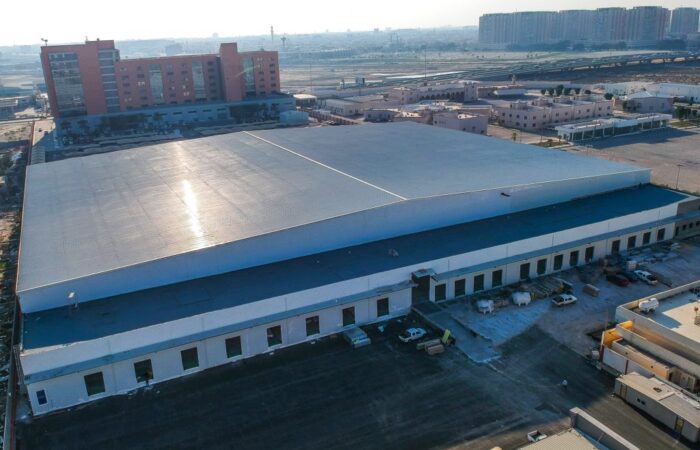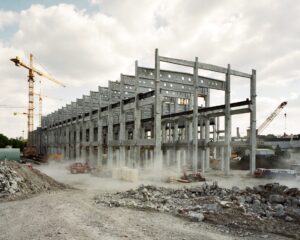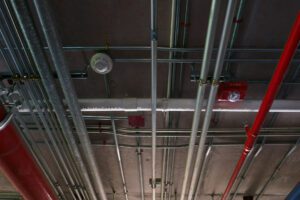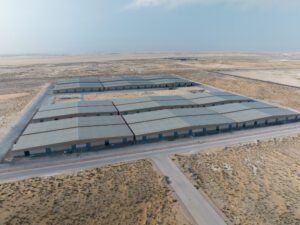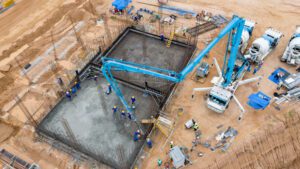New warehouses were not developed speculatively during the previous crisis. As soon as the economy started to improve again, new buildings were not being constructed fast enough to meet the rising demand for space.
Since this is the case, the warehouse occupancy rate throughout the country has hit an all-time high, hovering around in the mid-to-high 90% range in most areas.
Your business has to plan ahead to determine its storage and distribution needs. Finding a future facility that satisfies a high percentage of your criteria required for expansion is just as important as precisely planning for your present space demands.
There has to be a long-term plan for build-to-suit (BTS) construction if no appropriate buildings are now available. In any case, before visiting potential buildings, it is essential to first determine precisely how much space will be needed.
Use this checklist to assess your existing space needs and plan for future expansion.
Free Stacking Height
For the purposes of storing goods, supplies, and inventories in racking and shelves, the clear stack height is the available space. All of the building’s bar joists, lights, sprinkler heads, and ductwork are measured from their bases down to the ground floor.
Knowing the minimum clear height, the number of pallets you want to store, and the maximum pallet height is essential. More storage space will be needed if a low-ceilinged structure is chosen.
Most localities demand at least 18″ to 36″ of clearance from the sprinkler heads, so you’ll want to keep that in mind as well.
Most warehouses constructed in the 1960s have an average of 24 feet in height. Modern warehouses may reach heights of over 40 feet, greatly increasing their ability to store goods. For warehouses higher than 40 feet, high-reach pickers are a must.
Overall Sq. Ft.
It is crucial to factor in inventory and order volume increases at every stage of calculating your space requirements. The length of time you want to spend at the building should inform how much room you need.
Including the clear height in the calculation of the total square footage needed can help avoid under sizing the facility. Think about how much room you’ll need for product inspection, storage, and staging.
Bulk storage in relation to clear height and picking of merchandise must be determined whether a specialized picking module or pick zone is required.
Don’t only count the number of SKUs to determine your space requirements. Think about the number of bulk storage areas and pick bins you’ll need in light of your anticipated SKU and inventory increase.
Is there gokind of repercussions does this have on the amount of space needed for storage?
Think abouting to be a steady increase or decrease in inventory turns?
What how much room you’ll need for outgoing order packaging, shipping, and storing as well. Larger outward docks and staging areas for LTL and TL cargo waiting for routing, etc., are often necessary for wholesale distribution and manufacturing.
Alternatively, firms that focus on satisfying customers’ wants and needs often have no trouble with loading tiny delivery trucks.
Consider the necessary square footage for things like plant or facility maintenance, offices and breakrooms, kitting or other value-added services, conveyors and automation, and returns processing.
Closed Dock Doors
Many businesses fail to recognize its importance, and they often wish they had more of it. Don’t forget to factor in the potential expansion and the potential effect of containers when determining the number of dock doors required for the incoming acceptance of products.
On the piers where shipments leave the country, think about the shipping companies you use now and how that could change in the future.
How many LTL, TL, and small package carriers are needed, and how many various types of carriers are needed?
Will truckers be dropping off trailers all day, which might limit access to your facility?
Be sure you have plenty of each kind of door. There may not be any ramps or doors at ground level in a multi-tenant building with standard dock height doors. When taking in heavy or bulky objects, they may be a lifesaver.
Door configurations designed for small package carriers’ delivery vehicles may be an option for businesses that use these carriers for incoming or outgoing shipments. Finally, choose whether or not compactors and recycling bins will have doors. Because of them, the total number of doors in the building will be reduced.
Equipment For the Docks
If you’re working with an existing building, think about the dock equipment you’ll need and its current state. Dock shelters/ seals and pits or hydraulic dock levelers are standard in most modern structures.
Dock shelters are useful for preventing unwanted elements like dust, rain, insects, and rodents from entering the building. Instead of using manual dock plates or rickety edge-of-dock levelers, you should use a hydraulic dock leveler.
They reduce risk and are simpler to use. You should make sure that all of the dock doors are functioning properly.
Landlords are responsible for supplying in good working condition and not worn-out levelers and shelters. These will wear down over time and need repairs, but they are crucial to keeping the building functional.
Learn whether the landlord or developer will provide the dock equipment your business wants. Dock locks and safety lights may help prevent vehicles from pulling away from the docks inadvertently.
It’s possible that safety obstacles for unoccupied docks and additional inside illumination may be required.
Needed Electrical Components
This is a crucial component of a construction project that is often disregarded. Make sure the facility can handle the charging needs of your fleet of forklifts and order pickers. Problems may arise at even quite modest or somewhat large installations.
Lifts typically need 480V 3Phase, however not all buildings can provide it. One option is to launch a brand-new service, but doing so would need government approval, which might take up to two months.
Inquiring as to whether or whether the maker of your lift truck provides an optional charger is a faster option.
Take into account the conveyors, robotics, and other equipment in manufacturing and light assembly that will demand electricity. Lastly, think about the energy needed for sorting little packages.
Form and Footprint of the Building
How a structure is shaped may have a major effect on its functionality. L-shaped structures are equally as awful as their long and narrow counterparts.
Workflow and transportation issues arise when numerous tenants share a building with linear growth. They cause delays and more walking, both of which increase operational costs. It’s important to plan out the facility’s use and the whole flow, from inbound to outgoing operations.
Take into account the potential impact of the building’s other features on efficiency and effectiveness. Any dockside offices or other impediments should be reduced or removed if at all possible.
Having a complete picture of the dock’s activity (both incoming and outgoing) is essential for efficient management. Older industrial facilities may have some desirable features, but they may also include overhead cranes or other obstacles that reduce the available headroom or floor area.
In buildings with strange twists and passageways, useful square footage may be wasted. Recognize the potential adverse effects of these architectural features on your business.
Reception Area for Trucks
Find out how much space will be required for trailers to be staged in and out. In two to three years, your current requirements could not make sense at all. Would outbound carriers be picking up trailers or containers, and if so, will it affect the total number of trailers at the facility?
During busy periods, some businesses opt to store items like corrugated boxes and products on trailers so they can be easily dropped off at a dock entrance. Do you anticipate having comparable procedures, and if yes, how many mobile offices will be required to support them over the facility’s lifespan?
Many businesses rely on drop trailers for outbound transportation because it allows them to better manage peak volumes. This may imply having empty trailers in a yard to swiftly switch at the dock as required from trailers in the yard.
Many multi-tenant complexes have inadequate yard capabilities which might hinder flexibility.
Condition of the Floor
Checking the flooring’s condition before committing to a lease is crucial. The surface of the floor may wear away due to age and increased forklift and order picker use. When this happens, keeping the floor clean and in good condition becomes more challenging.
Think about the state of the floor as a whole and how it could affect your work. Older buildings sometimes have uneven floors and other defects that may be a problem for factories that use heavy manufacturing equipment. Do you want us to reseal the floor before you move in?
Landlords are responsible for repairing severely damaged floors before tenants move in. The upkeep and repair expenses for your lift trucks will skyrocket if they are subjected to constant shaking and collisions.
Condition of Employment
Companies seldom invest in air conditioning for their warehouses. Ample ventilation and circulation, however, are essential. Workplace conditions, including pick zones and assembly, should be evaluated by businesses.
It may be necessary to retrofit an existing building if the company’s needs include special environmental conditions, such as temperature or humidity regulation. Assessing the facility’s immediate and future requirements is crucial.
Warehouse lighting is a common issue for businesses. Sadly, their new rack design calls for mobile illumination. In addition, there has to be enough illumination for reading pick sheets and racking labels.
Return on investment (ROI) for high-efficiency LED lights and enough illumination may be achieved in as little as 18–24 months due to the reduction in energy costs.
Precautions in Case of Fire
Learn the county’s regulations on product categorization, sprinklers, and storage needs. Be sure the sprinkler heads are installed properly and that there is enough water pressure and volume to adequately protect the structure.
What is the maximum allowed height for storing various product types according to the local building codes? Concerning the welfare of the staff, how long does it take to get out of the building in an emergency?
Take Away
All of these specifics should be used to create a year-by-year breakdown of the building’s demands across all functional areas. Specifications like the width of the aisles, the number of workstations in each aisle, the number of employees per aisle, the size of the shipping dock, and the capacity of the receiving dock are all important considerations.

